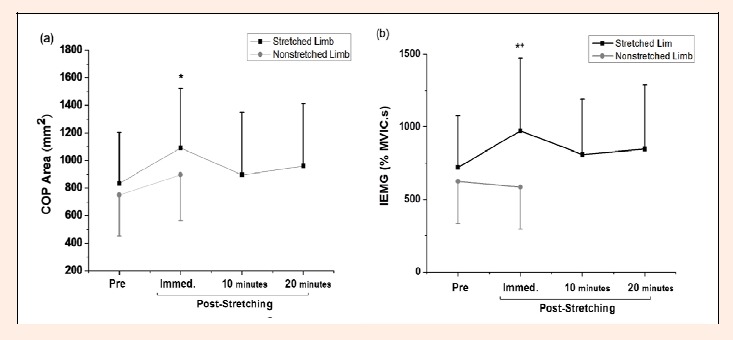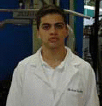Abstract
The aim of this study was to investigate the acute effects of unilateral ankle plantar flexors static- stretching on surface electromyography (sEMG) and the center of pressure (COP) during a single-leg balance task in both lower limbs. Fourteen young healthy, non-athletic individuals performed unipodal quiet standing for 30s before and after (stretched limb: immediately post-stretch, 10 and 20 minutes and non-stretched limb: immediately post-stretch) a unilateral ankle plantar flexor static- stretching protocol [6 sets of 45s/15s, 70-90% point of discomfort (POD)]. Postural sway was described using the COP area, COP speed (antero-posterior and medio-lateral directions) and COP frequency (antero-posterior and medio-lateral directions). Surface EMG (EMG integral [IEMG] and Median frequency[FM]) was used to describe the muscular activity of gastrocnemius lateralis. Ankle dorsiflexion passive range of motion increased in the stretched limb before and after the static-stretching protocol (mean ± SD: 15.0° ± 6.0 and 21.5° ± 7.0 [p < 0.001]). COP area and IEMG increased in the stretch limb between pre-stretching and immediately post-stretching (p = 0.015 and p = 0.036, respectively). In conclusion, our static- stretching protocol effectively increased passive ankle ROM. The increased ROM appears to increase postural sway and muscle activity; however these finding were only a temporary or transient effect.
Key Points.
The postural control can be affected by static- stretching protocol.
The lateral gastrocnemius muscle action was increased after the static- stretching protocol.
The static- stretching effects remain for less than 10 minutes.
Key words: Balance, postural stability, stabilometry, motor control
Introduction
Ankle sprains continue to occur frequently in athletes despite advances in prevention protocols to improve strength, flexibility, proprioception, and neuromuscular control (Beynnon et al., 2002; McKeon and Hertel, 2008). Previous evidence suggests that longer durations of static stretching negatively impact performance, whereas dynamic stretching either has no impact or can improve performance (Behm et al., 2001; 2004; Behm and Chaouachi, 2011; Behm and Kibele, 2007; Kokkonen et al., 1998; Young et al., 2006). However, making comparisons between studies is difficult, as the stretching protocols and acute variables of performance are often not similar (Behm and Chaouachi, 2011; Shrier, 2004). In addition, the necessary change in flexibility to indicate a clinically meaningful increase in the joint range of motion or muscle length after the stretching protocol is not agreed upon and is absent in the literature.
Those who support the practice of static stretching prior to athletic activities often include stretching as a way to slowly prepare the body as it transitions from a state of rest to one of activity, in order to increase the range of movement of joints and the flexibility of soft tissues such as muscles and tendons and to potentially reduce the risk of injury (Rubini et al., 2007). However, recent studies have reported static stretch-induced impairments in human performance (i.e., force, power, and coordination) attributed to effects on several biological systems (i.e., neurological, structural, cellular, and hormonal) (Avela et al., 2004; Behm et al., 2001; 2004; Behm and Chaouachi, 2011; Behm and Kibele, 2007; Pacheco et al., 2011; Rubini et al., 2007; Shrier, 2004; Thacker et al., 2004). Findings of altered human performance after static stretching may be related to changes in the musculo-tendinous unit (i.e., stiffness and torque-length characteristics), neural activity (i.e., mechanoreceptors of the skin and joints, Ia afferents, and Golgi tendon organs) and proprioception (Avela et al., 2004). Yet, the acute effects of a standardized static stretching protocol in increasing passive ankle range of motion and concurrent results in changes in performance measures such as postural sway remain unclear.
The control of posture while standing is a fundamental task achieved by a complex integration of the neuromuscular, vestibular, visual, and somatosensory systems (Horak, 2006; Jancová, 2008), and measures of postural sway while standing on one limb are repeatable and reliable measures (Muehlbauer et al., 2011). Ankle plantar flexors are considered postural tonic muscles and can affect postural control by managing ankle strategy (Gribble and Hertel, 2004). High volume of static stretch-induced can inhibit both afferent and mechanical responses, consequently negatively affecting postural control by reducing balance. Behm et al. (2004) analyzed the effects of a static stretching protocol on static balance using a 5-min warm-up followed by 3 x 45s at the discomfort point, with 15s rest periods, for the quadriceps, hamstrings, and plantar flexors of male university students and a control group. A significant impairment in balance was observed only for the stretch condition. Whether isolated stretching of the plantar flexors results in altered standing balance measures of the center of pressure (COP) remains unknown. Considering the positive cross-correlation between electromyography (sEMG) and COP (Kohn, 2005), measuring plantar flexor muscle activity while obtaining COP variables before and after the static stretching protocol could provide evidence regarding whether a neuromuscular change exists after stretching. Therefore, the purposes of the present study were to evaluate the acute effects of unilateral ankle plantar flexor static-stretching (1) on superficial electromyography (sEMG), passive range of motion (ROM), and COP measures of the stretched lower limb during single-leg balance tasks; (2) on the time course of sEMG and COP measures of the stretched lower limb.
Methods
Subjects
Based on a statistical power analysis derived from the COP area from our pilot study, ten subjects would be necessary to achieve an alpha level of 0.05 and a power (1-β) of 0.80 (Eng, 2003). Therefore, we recruited 14 young, healthy, non-trained individuals (seven males, age: 25 ± 3 years, height: 1.74 ± 0.05 m, and weight: 76 ± 8 kg and seven females, age: 22 ± 3 years, height: 1.64 ± 0.05 m, and weight: 59 ± 6kg) to participate in this study. The participants in the study had no previous surgery on the lower extremities; no history of injury with residual symptoms (e.g., pain, “giving-away” sensations) in the lower extremities within the last year; no evidence of a leg-length discrepancy (difference in distance from the anterior superior iliac spine to the superior surface of the most prominent aspect of the medial malleolus) of more than 1 cm; and no evidence of balance deficits (determined by oral questioning regarding falls). This study was approved by the research ethics committee of the Methodist University of Piracicaba, Brazil (Protocol #74/12).
Procedures
Prior to the data collection, the subjects were asked to identify the preferred leg for kicking a ball (Maulder and Cronin, 2005), which was then considered the dominant leg. Of the 14 subjects, 13 were right-leg dominant. The experimental protocol consisted of (1) a brief warm-up; (2) maximal voluntary isometric contraction (MVIC); (3) a pre-stretching evaluation (passive ROM and three trials of single-leg balance tasks for each lower limb); (4) ankle plantar flexor static-stretching protocol (only for dominant lower limb); (5) immediate post-stretching evaluation (passive ROM and three trials of single-leg balance tasks for each lower limb); and (6) post-stretching evaluation of the stretched lower limb (three trials of single-leg balance tasks after 10 and 20 minutes of the stretching protocol), considering the mechanical stress imposed by the static-stretching protocol only on that particular limb. All tasks were randomized among subjects and lower limbs, and all measures were performed at the same hour of the day, between 9 and 11 AM.
Single-leg balance task: The subjects were asked to keep one leg on the force plate and the other leg elevated, aligned with the contralateral malleolus and with the arms crossed on the chest. The subjects were instructed to stand as still as possible, with their eyes open, while concentrating on a point about 2-m away, at eye level. Each subject performed three trials of quiet standing for 30s followed by 60s of rest in the pre- and post-conditions of the static- stretching protocol; however, for the data analysis, we considered only the first trial for all post conditions, to avoid a wash-out effect. To measure the effects of unilateral ankle plantar flexor static- stretching of each lower limb during the single-leg balance task, we acquired force data from one force plate (Kistler model 9286A, Winterthur, Switzerland) and sEMG of the gastrocnemius lateralis (GL). The subjects performed the single-leg balance task before and after the unilateral ankle plantar flexor static- stretching protocol (only for the dominant lower limb). Using a 400-Hz sampling frequency, we recorded the ground reaction forces and moments from the force plate and used these data to calculate COP area, COP speed, and COP frequency. We chose those variables because they are considered the standard for measuring balance while standing (Jancová, 2008; Riemann et al., 1999).
Measures
Ankle Range of Motion (ROM): The subjects remained lying down with the lower limbs aligned and the ankle joint positioned in a neutral position (90º to the ground). Then, a researcher passively moved the ankle to the maximal ROM of the dorsiflexion movement. The maximal passive ankle ROM was evaluated before and after the static-stretching protocol with a fleximeter (Sanny, Brazil).
Surface electromyography (sEMG) recording: The participants’ skin was prepared before placement of the EMG electrodes. Hair at the site of electrode placement was shaved and the skin was cleaned with alcohol. Bipolar passive disposable dual Ag/AgCl snap electrodes 1cm in diameter for each circular conductive area and 2cm center-to-center spacing were placed bilaterally over the longitudinal axes of the GL in the direction of the line between the head of the fibula and the heel, according to the SENIAM/ISEKI protocol (Hermens et al., 2000). The sEMG signals of the GLs of both lower limbs were recorded by an electromyographic acquisition system (FREEMG 300; BTS Bioengineering, Milan, Italy) during MVIC and for the entire 30s of all single-leg balance trials. The sEMG signals were recorded with a preamplifier (gain 1,000x), common mode rejection >-85 dB; the sampling frequency was 1000 Hz. The criterion to normalize the sEMG data was the peak of the root mean square (RMS) of the MVIC data. To measure MVIC, the subjects were kept standing with their ankles positioned in a neutral position, and they were asked to perform three MVICs for 5s against a fixed resistance training device.
Intervention
Unilateral ankle plantar flexor stretching protocol: During the stretching protocol, the subjects remained lying down with the knee extended; the static- stretching protocol consisted of a passive dorsiflexion stretch of the dominant lower limb only. The subjects performed six stretches of 45s with 15s rest periods in between. The intensity was 70-90% of the point of discomfort (POD), where 0="no stretch discomfort at all" and 100%="the maximum imaginable stretch discomfort" (Behm and Chaouachi, 2011; Behm and Kibele, 2007). The POD intensity was required from the subjects during all stretches and the ROM was readjusted at 70-90% POD as necessary. The static- stretching protocol was applied and controlled (POD) by the same strength and conditioning researcher. During the rest periods, the subjects remained seated on a chair (10 and 20 minutes).
Data analysis
All of the force plate and sEMG data were analyzed with a customized Matlab routine (MathWorks Inc., USA).
Center of pressure (COP) analysis: To remove the offset of the COP data, the mean was subtracted from each time series. For the single-leg balance trials, the COP data were filtered with a fourth-order 10Hz low-pass zero-lag Butterworth filter. Using the data of the single-leg balance trial, we computed the COP area and the following variables in the anteroposterior (a-p) and mediolateral (m-l) directions: COP speed and COP frequency. The COP area was estimated by fitting an ellipse that encompassed 95% of the total COP data (Duarte & Freitas, 2010; Freitas, Prado, & Duarte, 2005). The COP speed was calculated by dividing the COP resultant displacement by the total 30s period of the trial in each direction (a-p and m-l). The frequency of the COP displacement in each direction (a-p and m-l) was calculated by determining the frequency at which less than 80% of the COP spectral power occurred. The 80% cutoff value was chosen based on previous work (Baratto et al., 2002) that suggested this value is a superior discriminator for COP data compared to other spectral measurements. The power spectral density was estimated by the Welch periodogram of the detrended data, with a resolution of 0.039 Hz (Baratto et al., 2002; Duarte and Freitas, 2010).
Surface electromyography (sEMG) analysis: The digitized sEMG data was first band-pass filtered at 20-400 Hz using a fourth-order Butterworth filter with a zero lag. We then removed the first and last seconds of sEMG data and evaluated the entire 28 seconds of the balance tasks. For the time domain analysis, we calculated the RMS (150ms moving window) of the sEMG data and MVIC. The RMS data was then normalized by the mean of the RMS peak from the three MVICs, and the RMS data was integrated (IEMG). For the frequency analysis, the sEMG data was analyzed by a short-time Fourier transform and the median frequency (MF) of the spectrum was computed.
Statistical analyses
The normality and homogeneity of variances within the data were confirmed with the Shapiro- Wilk and Levene tests, respectively. To compare the effects of the ankle dorsiflexion passive ROM, we used a paired t-test before and after the static- stretching protocol. To test whether the static- stretching protocol resulted in postural sway [COP area, COP speed (a-p and m-l directions), frequency (a-p and m-l directions)] and muscle activity differences (IEMG and MF), a repeated- measures two-factor ANOVA was used, with factors being the lower limb (stretched and non-stretched) and conditions (pre-stretching and immediately post-stretching). Another one-way ANOVA was completed to test whether prolonged changes in postural sway and sEMG variables continued over time (pre, immediately post, and after 10 and 20 minutes of the static- stretching protocol) for the stretched lower limb. Post- hoc comparisons were performed with the Bonferroni test. Cohen’s formula for effect size (ES) was calculated, and the results were based on the following criteria: <0.50 trivial effect; 0.50-1.25 small effect; 1.25-1.9 moderate effect; and >2.0 large effect, for untrained according to Rhea (2004). An alpha of 5% was used for all statistical tests.
Results
The results of flexibility measured by passive ROM revealed significant increases between the measurements taken before and those taken after the static- stretching protocol (mean ± SD: 15.0 ± 6.0° and 21.5 ± 7.0°, respectively [p < 0.001, ES = 0.95, Δ% = 30.2]). Regarding balance variables (Table 1), immediately after the static- stretching protocol, the COP area of the stretched limb was larger (p = 0.015, ES = 0.63, Δ% = 23.5) (Figure 1a).
Table 1.
Means (±standard deviations) of the sEMG and COP variables before and after static- stretching protocol for stretched and non-stretched lower limbs.
| Measure | Variable | Lower Limb | Conditions | |||
|---|---|---|---|---|---|---|
| Pre-Stretching | Post-Stretching | |||||
| Immediately | 10 min. | 20 min. | ||||
| sEMG |
Median Frequency (Hz) |
STR | 90.3 (17.0) | 89.4 (18.0) | 89.7 (18.0) | 84.0 (22.0) |
| NSTR | 88.1 (14.0) | 83.6 (13.7) | - | - | ||
| COP |
Speed (a-p) (mm·s-1) |
STR | 28.1 (5.7) | 29.9 (10.3) | 26.5 (5.7) | 25.1 (7.1) |
| NSTR | 26.2 (6.3) | 28.5 (9.8) | --- | --- | ||
|
Speed (m-l) (mm·s-1) |
STR | 23.2 (5.3) | 26.6 (14.6) | 22.5 (6.2) | 21.7 (4.69) | |
| NSTR | 21.1 (3.8) | 21.9 (5.1) | --- | --- | ||
|
Frequency (a-p) (Hz) |
STR | 1.06 (.24) | .87 (.16) | .96 (.20) | .84 (.23) | |
| NSTR | 1.1 (.28) | .82 (.18) | --- | --- | ||
|
Frequency (m-l) (Hz) |
STR | .65 (.23) | .62 (.25) | .72 (.36) | .59 (.19) | |
| NSTR | .51 (.19) | .74 (.28) | --- | --- | ||
STR = stretched lower limb; NSTR = non-stretched lower limb.
Figure 1.

Mean and standard deviation of the (a) COP area and (b) IEMG before and after static- stretching protocol for stretched and non-stretched lower limbs. * Significant difference between pre- and post-stretching in the stretched limb, p < 0.05. + Significant difference between lower limbs to the same post-stretching condition, p < 0.05.
There were increases in balance test IEMG between pre-stretching and immediately post-stretching of the stretched lower limb (p = 0.036, ES = 0.58, Δ% = 25.9) and between the lower limbs immediately post-stretching (p = 0.043, ES = 0.95, Δ% = 39.8) (Figure 1b). Table 1 shows all sEMG and COP variables, without significant differences.
Discussion
This study demonstrated that the acute effects of unilateral ankle plantar flexor static- stretching significantly increased ankle dorsiflexion passive ROM, GL muscle activity, and COP area in the stretched limb compared with the non-stretched limb when tested immediately after the static- stretching protocol. However, these changes were no longer significantly different after 10 minutes of resting.
Importantly, our combination of total volume (270s) and level of intensity (70-90% POD) of the present static- stretching protocol of the ankle plantar flexors was effective at increasing the ankle passive ROM by 30.2% in the ankle joint, thereby changing the balance measures and GL muscle activity.
In the balance results, the subjects displayed an alteration of their postural control in the stretched lower limb only, and the balance changes were observed only immediately after the static- stretching protocol. We only observed an increase in the COP area immediately after the ankle plantar flexor static- stretching protocol in the stretched lower limb. Our subjects’ increased COP area during the single-leg balance task suggests impaired balance performance [i.e., characterized by the ability to minimize postural sway (Hrysomallis, 2011; Paillard et al. 2006; Zverev, 2006)]. These stretch-induced results might be related to changes in both peripheral neural (proprioception) and mechanical output (musculo-tendinous unit or stiffness) affecting the ability to adapt adequately to the stability challenges (Behm et al., 2004). The prolonged static- stretching protocol may have reduced the stiffness of the joint, fascia, and musculo-tendinous unit, thus hindering balance during the single-leg balance task. These changes might affect the muscle afferent input to the central nervous system and the muscle output during balance (Avela et al., 2004; Behm et al., 2004). However, the absolute mean change in the COP area from pre- to immediately post-stretching values increased in both the stretched and non-stretched lower limbs.
During the single-leg balance task, both the gastrocnemius (medialis and lateralis) and the soleus were active in maintaining balance (Tokuno et., 2007; Tole-Hodson et al., 2013), and the triceps surae was involved in reducing plantar flexion and stabilization of the ankle complex in the sagittal plane (Kinugasa et al., 2005). Tokuno et al. (2007) observed no statistical differences between two muscles (soleus and gastrocnemius medialis) during balance, indicating that differential control between them is not required. Therefore, it seems that both muscles (soleus and gastrocnemius) are recruited during low-intensity tasks such as quiet standing (Jacono et al., 2004). Regarding muscle activation after the static- stretching protocol, the sEMG of the GL showed increases in the activation pattern only for the stretched lower limb immediately after the static- stretching protocol. Several factors could possibly affect muscle activation after passive stretching, such as neuromuscular feedback responses [Golgi tendon reflex, mechanoreceptor (type III afferent)] and mechanical changes [muscle stiffness, force-length relationship] (Avela et al., 2004; Behm et al., 2001; 2004; Behm and Chaouachi, 2011; Behm and Kibele, 2007; Pacheco et al., 2011; Rubini et al., 2007; Shrier, 2004; Thacker et al., 2004). Acute static- stretching protocols can change the length and stiffness of the musculotendinous unit, the sEMG responses, the transmission of forces, the rate of force transmission, and the electromechanical delay and provide a change in an optimal cross-bridge overlap (Behm and Kibele, 2007).
During the single-leg balance tasks, our findings showed an increase in sEMG after the static- stretching protocol, which was not in agreement with previous studies that observed a reduction in the muscle activation after static- stretching protocols (Avela et al., 2004; Behm et al., 2001; Behm and Chaouachi, 2011; Bley et al., 2012; Fowles et al., 1997; 2000). The changes in muscle length might alter the relationship between joint kinematics and muscle activation that together can produce a certain level of force considering a specific joint angle (Fowles et al., 2000). Therefore, after the static- stretching protocol, the length-force relationship might be altered, influencing proprioceptive feedback and coordination. The effects of prolonged and intense static- stretching on the joint receptors might lead to inhibitory effects on motoneurons, and their greatest effects can remain for 5-10 minutes (Behm and Kibele, 2007). That finding supported the results of our study that the time of the static- stretching protocol affected muscle activation (GL activity) only immediately after the experimental protocol. However, Fowles et al. (2000) showed a reduction in force and sEMG after static- stretching, as well as recovery to the initial values over time (30 minutes). This may be due to the combination of high characteristic variable loads (135s of 13 stretches over 33 min). It is possible that the level of muscle activation during specific ankle joint positions in the single-leg balance task was changed after the static- stretching protocol, and that the subsequent demand for muscle activation for joint stabilization and to keep the same joint position became higher.
We recognize that this study has some limitations. The placement of the sEMG electrodes over the GL might have led to cross-talk from adjacent muscles, such as the soleus, tibialis, and peroneal muscles. Foot type (pronated or supinated foot) can affect postural control during the balance task, as considered by Hertel et al. (2002) and Cote et al. (2005). The feet touching on the floor during the resting period might affect the static dorsiflexion stretching effect. We analyzed only the open-eye condition; however, the subjects were instructed to keep their eyes fixed on a specific point (Nagano et al., 2006). We chose to use the most progressive static- stretching protocol in the literature that included subjective information about the stretching intensity (Behm and Chaouachi, 2011). However, we do recognize that the intensity of the stretching might not be commonly utilized during warm-ups to activity or during the rehabilitation processes. In addition, we can relate the high variability of the data (COP and sEMG) with the inter-subject differences of the stretching protocol intensity.
We also used a healthy, non-athletic population, and our results are not generalizable to other conditions, populations, and diseases. However, the study will inform sport scientists, strength and conditioning coaches, physiotherapists, and athletic trainers about the effects of an intense static- stretching protocol and its effects on balance and muscle activity, as well as the time needed for these changes. When considering whether or not to stretch prior to athletic activities, one must consider the potential effects of increased bony congruency with increased ankle dorsiflexion motion with the potential deleterious effects of increased sway and muscle activity during a simple balance task or as part of the rehabilitation process.
Conclusion
In conclusion, our static- stretching protocol effectively increased passive ankle ROM. The increased ROM appears to increase postural sway and muscle activity; however these finding were only a temporary or transient effect (less than 10 minutes after the static- stretching protocol applied). Whether the increased ankle ROM and subsequent increase in COP area and muscle activity influence the risk of ankle injury and instability remains unknown.
Biographies

Bráulio N. Lima
Employment
Physical Educator
Degree
MSc
Research interests
Biomechanics
E-mail: braulionl@hotmail.com

Paulo R.G. Lucareli
Employment
Associated Professor
Degree
PhD
Research interests
Biomechanics, motor control
E-mail: plucareli@hotmail.com

Willy A. Gomes
Employment
Physical Educator
Degree
MSc
Research interests
Biomechanics
E-mail: willy_edfisica@yahoo.com.br

Josinaldo J. Silva
Employment
Physical Educator
Degree
MSc
Research interests
Biomechanics
E-mail: jarbaspersonal@hotmail.com

Andre S. Bley
Employment
Physiotherapist.
Degree
MSc
Research interests
Sports Physiotherapy, biomechanics
E-mail: andrebley@hotmail.com

Erin H. Hartigan
Employment
Assistant Professor
Degree
PhD
Research interests
Lower extremity musculoskeletal disorders
E-mail: ehartigan@une.edu

Paulo H. Marchetti
Employment
Associated Professor
Degree
PhD
Research interests
Postural control, biomechanics, resisitance training, Stretching
E-mail: dr.pmarchetti@gmail.com
References
- Avela J., Finni T., Liikavainio T., Niemela E., Komi P. V. (2004) Neural and mechanical responses of the triceps surae muscle group after 1h of repeated fast passive stretches. Journal of Applied Physiology 96, 2325-2332 [DOI] [PubMed] [Google Scholar]
- Baratto L., Morasso P.G., Re C., Spada G. (2002) A new look at posturographic analysis in the clinical context: sway-density versus other parameterization techniques? Motor Control 6(3), 246-270 [DOI] [PubMed] [Google Scholar]
- Behm D.G., Bambury A., Cahill F., Power K. (2004) Effect of acute static stretching on force, balance, reaction time, and movement time? Medicine Science and Sports Exercise 36(8), 1397-1402 [DOI] [PubMed] [Google Scholar]
- Behm D.G., Buttom D., Butt J. (2001) Factors affecting force loss with prolonged stretching. Canadian Journal of Applied Physiology 26, 262-272 [PubMed] [Google Scholar]
- Behm D.G., Chaouachi A. (2011) A review of the acute effects of static and dynamic stretching on performance. European Journal of Applied Physiology 111, 2633-2651 [DOI] [PubMed] [Google Scholar]
- Behm D.G., Kibele A. (2007) Effects of differing intensities of static stretching on jump performance. European Journal of Applied Physiology 101, 587-594 [DOI] [PubMed] [Google Scholar]
- Beynnon B.D., Murphy D.F., Alosa D.M. (2002) Predective factors for lateral ankle sprains: a literature review. Journal of Athletic Training 37, 376-380 [PMC free article] [PubMed] [Google Scholar]
- Bley A.S., Nardi P.S.M., Marchetti P.H. (2012) Alongamento passivo agudo não afeta a atividade muscular máxima dos isquiotibiais? Motricidade 8(4), 80-86 [Google Scholar]
- Cote K.P., Brunet M.E., Gansneder B.M., Shultz S.J. (2005) Effects of Pronated and Supinated Foot Postures on Static and Dynamic Postural Stability? Journal of Athletic Training 40(1), 41-46 [PMC free article] [PubMed] [Google Scholar]
- Duarte M., Freitas S.M.S.F. (2010) Revision of posturography based on force plate for balance evaluation? Revista Brasileira de Fisioterapia 14(3), 183-192 [PubMed] [Google Scholar]
- Eng J. (2003) Sample Size Estimation: How many individuals should be studied? Radiology 227(2), 309-313 [DOI] [PubMed] [Google Scholar]
- Fowles J.R., Sale D.G., MacDougall J.D. (1997) Time course of strength deficit after maximal passive stretch in humans. Medical Science and Sports Exercise 29, S26 [Google Scholar]
- Fowles J.R., Sale D.G., MacDougall J.D. (2000) Reduced strength after passive stretch of the human plantarflexors. Journal of Applied Physiology 89, 1179-1188 [DOI] [PubMed] [Google Scholar]
- Freitas S.M., Prado J.M., Duarte M. (2005) The use of a safety harness does not affect body sway during quiet standing? Clinical Biomechanics (Bristol, Avon) 20(3), 336-339 [DOI] [PubMed] [Google Scholar]
- Gribble P.A., Hertel J. (2004) Effect of hip and ankle muscle fatigue on unipedal postural control? Journal of Electromyography and Kinesiology 14(6), 641-646 [DOI] [PubMed] [Google Scholar]
- Hermens H.J., Freriks B., Disselhorst-Klug C., Rau G. (2000) Development of recommendations for SEMG sensors and sensor placement procedures? Journal of Electromyography and Kinesiology 10(5), 361-374 [DOI] [PubMed] [Google Scholar]
- Hertel J., Gay M.R., Denegar C.R. (2002) Differences in Postural Control During Single-Leg Stance Among Healthy Individuals With Different Foot Types? Journal of Athletic Training 37(2), 129-132 [PMC free article] [PubMed] [Google Scholar]
- Horak F.B. (2006) Postural orientation and equilibrium: what do we need to know about neural control of balance to prevent falls? Age and Ageing 35(Suppl. 2), ii7-ii11 [DOI] [PubMed] [Google Scholar]
- Hrysomallis C. (2011). Balance ability and athletic performance. Sports Medicine 41(3), 221-232 [DOI] [PubMed] [Google Scholar]
- Jacono M., Casadio M., Morasso P.G., Sanquineti V. (2004) Sway-density curve and the underlying postural stabilization process. Motor Control 8, 292-311 [DOI] [PubMed] [Google Scholar]
- Jancová J. (2008) Measuring the balance control system - Review? Acta Medica 51(3), 129-137 [PubMed] [Google Scholar]
- Kinugasa R., Kawakami Y., Fukunaga T. (2005) Muscle activation and its distribution within human triceps surae muscles. Journal of Applied Physiology 99, 1149-1156 [DOI] [PubMed] [Google Scholar]
- Kohn A.F. (2005) Cross-correlation between EMG and center of gravity during quiet stance: theory and simulations? Biol Cybern 93(5), 382-388 [DOI] [PubMed] [Google Scholar]
- Kokkonen J., Nelson A.G., Cornwell A. (1998) Acute muscle stretching inhibits maximal strength perfomance? Research of Quarterly Exercise and Sport 69(4), 411-415 [DOI] [PubMed] [Google Scholar]
- Maulder P., Cronin J. (2005) Horizontal and vertical jump assessment: reliability, symmetry, discriminative and predictive ability? Physical Therapy in Sport 6(2), 74-82 [Google Scholar]
- McKeon P.O., Hertel J. (2008) Systematic review of postural control and lateral ankle instability, Part II: is balance training clinically effective? Journal of Athletic Training 43(3), 305-315 [DOI] [PMC free article] [PubMed] [Google Scholar]
- Muehlbauer T., Roth R., Mueller S., Granacher U. (2011) Intra and intersession reliability of balance measures during one-leg standing in young adults? Journal os Strength and Conditioning Research 25(8), 2228-2234 [DOI] [PubMed] [Google Scholar]
- Nagano A., Yoshioka S., Hay D. C., Himeno R., Fukashiro S. (2006) Influence of vision and static stretch of the calf muscles on postural sway during quiet standing? Human Movement Science 25(3), 422-434 [DOI] [PubMed] [Google Scholar]
- Pacheco L., Balius R., Aliste L., Pujol M., Pedret C. (2011) The acute effects of different stretching exercises on jump performance? Journal of Strength and Conditioning Research 25(11), 2991-2998 [DOI] [PubMed] [Google Scholar]
- Paillard T., Noé F., Rivière T., Marion V., Montoya R., Dupui P. (2006) Postural performance and strategy in the unipedal stance of soccer players at different levels of competition? Journal of Athletic Training 41(2), 172-176 [PMC free article] [PubMed] [Google Scholar]
- Rhea M.R. (2004) Determining the magnitude of treatment effects in strength training research through the use of the effect size? Journal of Strength and Conditioning Research 18(4), 918-920 [DOI] [PubMed] [Google Scholar]
- Riemann B.L., Guskiewicz K.M., Shields E.W. (1999) Relationship between clinical and forceplate measures of postural stability. Journal of Sport Rehabilitation 8, 71-82 [Google Scholar]
- Rubini E.C., Costa A.L.L., Gomes S.C. (2007) The effects of stretching on strength performance? Sports Medicine 37(3), 213-224 [DOI] [PubMed] [Google Scholar]
- Shrier I. (2004) Does stretching improve performance? A systematic and critical review of the literature? Clinical Journal of Sport Medicine 14(5), 267-273 [DOI] [PubMed] [Google Scholar]
- Thacker S.B., Gilchrist J., Stroup D.F., Kimsey D. (2004) The impact of stretching on sports injury risk: a systematic review of the literature? Medicine & Science in Sports & Exercise 36(3), 371-378 [DOI] [PubMed] [Google Scholar]
- Tokuno C.D., Carpenter M.G., Thorstensson A., Garland S.J., Cresswell A.G. (2007) Control of the triceps surae during the postural sway of quiet standing. Acta Physiologica 191, 229-236 [DOI] [PubMed] [Google Scholar]
- Tole-Hodson E.F., Loran I.D., Vieira T.M.M. (2013) Myoeletric activity along human gastrocnemius medialis: Different spatial distributions of postural and electrically elicited surface potentials. Journal of Electromyography and Kinesiology 23, 43-50 [DOI] [PMC free article] [PubMed] [Google Scholar]
- Young W., Elias G., Power J. (2006) Effects of static stretching volume and intensity on plantar flexor explosive force production and range of motion. The Journal of Sports Medicine and Physical Fitness 46, 403-411 [PubMed] [Google Scholar]
- Zverev Y.P. (2006) Spatial parameters of walking gait and footedness? Annals of Human Biology 33(2), 161-176 [DOI] [PubMed] [Google Scholar]


